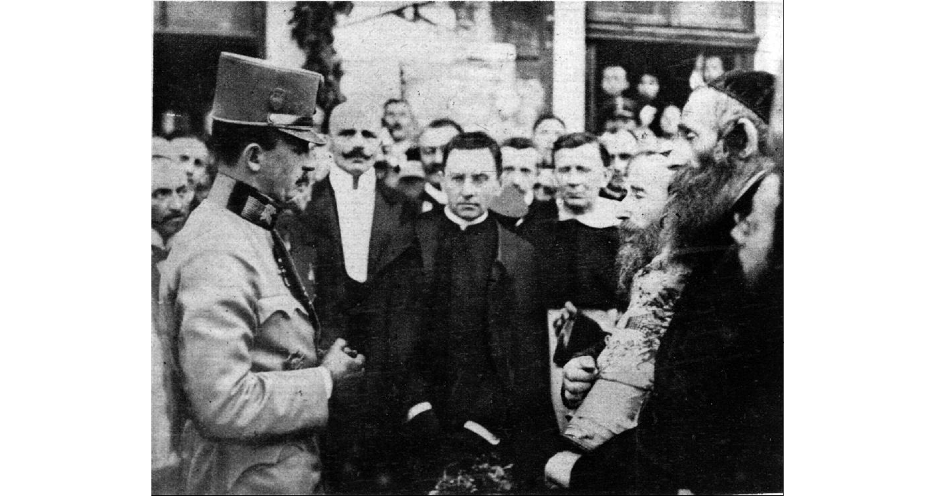 |
| Easter in Galicia during World War One. Notice the Easter breads and eggs. Austrian soldiers wore gray, Russians brown. It is had to decide the color of these uniforms. Painting by S. Kolesnikov. |
The Russian Grand Duke Nicholas, commander of
the Russian Army, stated in a 1914 manifesto that the people of Galicia were
“brothers who had languished for centuries under a foreign yoke.” He
urged the people of Galicia to unite with Russia under the rule of the Tsar. This idea, Pan-Slavism, called for all people who spoke
Slavic languages and shared culture to be united
under the rule of Russia, which they considered to be the center of Slavic
culture and religion. This was reflected by Russian support of Serbia after the
assassination of the Austrian Archduke Franz Ferdinand by a group of Serbian
nationalists. Russia declared war
on Austria-Hungary, shortly after Austria-Hungary declared war on Serbia in
June of 1914. Although Russia had never
ruled Galicia or Serbia, it considered the people of Galicia, like the Serbs, to be
fellow Slavs, and should be united under Russian rule.
 |
| Grand Duke Nicholas of Russia, in Lviv, 1914 |
When the Russian Army invaded Eastern Galicia in August of 1914, Austrian schools were closed immediately, and eventually replaced with
Russian language schools. Greek Catholic Churches, which served the
Ukrainian population, were closed, the priests arrested and replaced by priests
from the Russian Orthodox Church. The head of the Greek Catholic Church,
Metropolitan Sheptysky, was arrested and exiled to Russia. Ukrainian political
and cultural leaders in Galicia also were arrested and/or deported.
Jews made up 10% population in Galicia, and had
been living there for centuries. At the outbreak of the War, the population of
the city of Ternopil was about half Jewish, half Polish, and 10% Ukrainian. Most of the Jews were tradesmen or craftsmen. Jews were better
educated than the Ukrainians and Poles, as a result, most of the professional
people in Galicia were Jewish. Since the Austrian government encouraged
education of its people, it provided schools for all their subject people in their own language. The Austrian
government also encouraged participation of the people in government, so many
Jews, Poles and Ukrainians were elected to local and regional assemblies. Jews
were allowed to own property in the Austrian-Hungarian Empire, which was not
allowed in Russia. When the war
broke out, most Galician Jews and Ukrainians favored the Austrians, since they
believed that their government had treated them well. Both Ukrainians and Jews supported the Austrians, and because of this, when the war started, many Jews and Ukrainians, including at least two of my uncles, served in the Austrian army.
When the Russian Army invaded Eastern Galicia in
August 1914, many Jews decided to leave
Galicia, relocating to other parts of the Empire, especially to Vienna. Those
who remained lost personal property and had their movements limited, some were expelled. In
February 1915, the Russian governor of Galicia banned all correspondence and
publications in the Yiddish language. This was tragic, as Galicia was a center
of Yiddish culture and literature. There were several newspapers published in Yiddish and a thriving Yiddish theater, as well as many book publishers in the larger cities of Galicia.
In the
village of Bila, just east of Ternopil, home of my ancestors, all Christian households were required
to display icons on the gates of their houses, which made identifying Jewish
households easy, and made them subject to punishment. My aunt Katherine said that Jews were beaten unmercifully because the Russians considered
them to be crooked and unjust. they also accused Jews of espionage or collaboration with the enemy. Katherine witnessed the Russians closing saloons run by Jews and
the beer and liquor was poured into the village street.
In 1916, when the Austrian Emperor Franz Joseph died, Katherine said that a picture was sold in the village of the emperor in his casket, surrounded by his family. The villagers honored him by displaying the picture in their homes. At that time, The Russians ruled the area, It was illegal to display the picture. If it wasn't destroyed immediately, people would pay with their lives.
In 1916, when the Austrian Emperor Franz Joseph died, Katherine said that a picture was sold in the village of the emperor in his casket, surrounded by his family. The villagers honored him by displaying the picture in their homes. At that time, The Russians ruled the area, It was illegal to display the picture. If it wasn't destroyed immediately, people would pay with their lives.
 |
| Picture of Emperor Franz Joseph in his coffin, similar to the picture the villagers displayed in Bila |
Katherine said that "The Russians were never sympathetic to the Ukrainians as the Austrians were. The Jews of Galicia also honored the Emperor, and he was mourned by Jewish communities all over Austria. Many Jews believed that the death of Franz Joseph was the end of the freedom they enjoyed to practice their religion and way of life. They didn't think that Austria-Hungary would survive the death of the Emperor. It did survive, but not for long.

I am frequent visitor of your website as i love to read out the articles posted on your website. At the same time i request to post some great article on TERNOPIL NATIONAL MEDICAL UNIVERSITYand similar as well. Thanks !!!
ReplyDelete